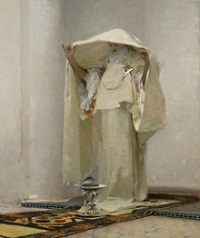Homer and Sargent
from the Clark
June 22–November 30, 2008

John Singer Sargent
Fumée d'Ambre Gris (Smoke of Ambergris)
From intimate glimpses of Venetian street life to tumultuous scenes of water meeting shore, John Singer Sargent and Winslow Homer created paintings that compel us to look—and to linger. For this inaugural exhibition at Stone Hill Center, we invite you to slow down and savor a number of the Clark’s masterpieces by these two great artists in contemplative spaces that connect art and nature. These bold paintings complement the softly painted works featured in Like Breath on Glass: Whistler, Inness, and the Art of Painting Softly, on view in the Clark’s main exhibition galleries.
Winslow Homer
Throughout his career, Winslow Homer (1836–1910) reveled in nature, spending long periods at work and play in the Adirondacks, Canada, and the Caribbean. His decision in 1883 to live in Prout’s Neck, Maine—far from urban art centers, and the site documented in five of the paintings in this gallery—testifies to how powerfully he felt the lure of the sea.
Sterling Clark counted Homer among the nineteenth century’s greatest artists. He acquired his first Homer picture in 1915 and continued to collect works by the artist for the next forty years, eventually owning over 200 oils, watercolors, and works on paper by Homer, more than by any other artist. This gallery holds seven of the finest paintings. In 2005, in celebration of the Clark’s fiftieth anniversary, visitors and friends chose three of them—Sleigh Ride, Two Guides, and West Point, Prout’s Neck—to be among their “50 Favorites.”
John Singer Sargent
“I am persuaded that Paris is the place to learn painting,” wrote the young John Singer Sargent (1856–1925) after his arrival there in 1874. Within five years he had not only learned to paint but had also gained an international reputation. The pictures in this gallery reveal his formidable talents. Sargent’s technical virtuosity is on full display in the paintings he made for the official Salon, including Carolus-Duran (a portrait of his teacher) and Fumée d’ambre gris, as well as more formally bold canvases such as the two Venetian scenes. The lively portrait of Madame Escudier demonstrates the sensibility that made Sargent one of the most sought-after portraitists of his day.
When Sterling Clark acquired Venetian Interior in 1913—his first purchase of a work by an American artist—Sargent was at the height of his fame. By 1939 Clark owned a dozen of Sargent’s oils. In 2005, friends and visitors to the Clark selected Fumée d’ambre gris as their favorite work in the collection.